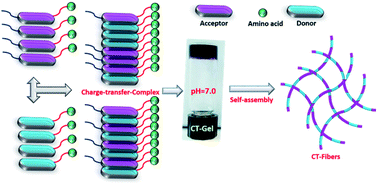The role of amino acids on supramolecular co-assembly of naphthalenediimide–pyrene based hydrogelators†
Abstract
This report describes the two component self-assembly of π-capped amino acid hydrogelators (serine (S), aspartic acid (D), glutamic acid (E) or lysine (K)) prepared from pyrene (Py) based donor and naphthalenediimide (NDI) based acceptor molecules. The co-assembly can be triggered to form hydrogels by varying the pH conditions and the major driving forces behind the hydrogelation were found to be the formation of a strong charge-transfer (CT) complex and hydrogen bonding interactions at suitable pH conditions. The NDI–Py blends with matched donor/acceptor amino acid pairs undergo self-assembly under acidic pH conditions, whereas the blend (NDI–S + Py–K) with a mismatched amino acid pair forms a stable hydrogel under physiological pH conditions. UV-Vis, FTIR and rheological studies clearly indicate the formation and the stability of these CT-induced hydrogels. These hydrogels are of nanofibrous morphology with an average diameter of about 6–9 nm as evidenced by TEM analysis. In addition, this novel NDI–Py mixed component system exhibited good biocompatibility towards PC3 cells. Overall, since hydrogels based on CT-mediated two-component assemblies are very rare, our newly discovered NDI–Py hydrogels provide chemical insights into the design of a CT-induced hydrogelator and might facilitate various applications in biomedical engineering.

- This article is part of the themed collections: Editors' collection: Supramolecular Polymers and Editors’ collection: Supramolecular Chemistry


 Please wait while we load your content...
Please wait while we load your content...